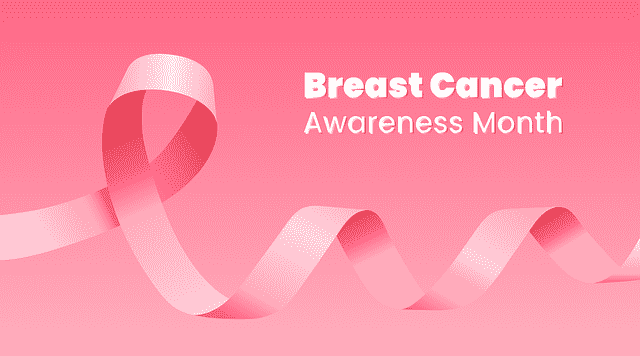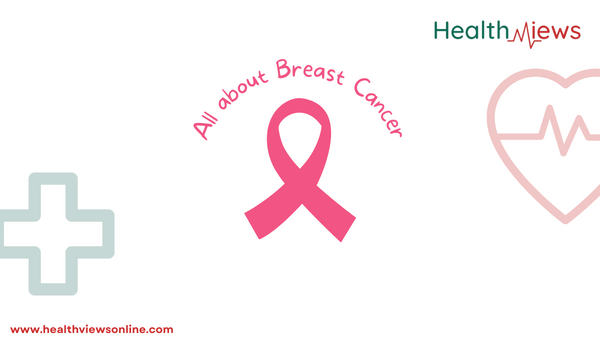What is Breast Cancer?
Breast cancer is a type of cancer that starts in the breast. It could appear in one or both breasts. Breast cancer occurs when cells in your breast proliferate. These cells divide faster than healthy cells and continue to clump together, forming a lump or mass known as a tumor.
After skin cancer, breast cancer is the second most frequent malignancy among women. It often develops from cells located in the glandular tissue known as lobules, the milk producing ducts (invasive ductal carcinoma), or other tissues or cells within the breast. Breast cancer can spread outside of the breast via the blood and lymph vessels. When breast cancer spreads to other parts of the body, it is considered to have metastasized.

Types
There are numerous forms of breast cancer including:
- Ductal Carcinoma In Situ (DCIS) – DCIS is sometimes known as stage 0 breast cancer or intraductal carcinoma. Non-invasive or early-stage breast cancer is DCIS.
- Invasive Breast Cancer (IDC/ILC) – Invasive breast cancers are breast tumors that have spread to nearby breast tissue.
- Triple-negative Breast Cancer – These cancers tend to affect women under the age of 40 who are Black or carry the BRCA1 mutation more frequently.
- Inflammatory Breast Cancer – IBC causes breast inflammation symptoms including swelling and redness, which are brought on by cancer cells obstructing lymphatic veins in the skin and giving the breast an “inflamed” appearance.
- Paget Disease of the Breast – A rare form of breast cancer that affects the skin of the nipple and areola is called Paget disease of the breast (the dark circle around the nipple).
- Angiosarcoma – Angiosarcoma is a rare type of cancer that begins in the cells that line blood and lymph arteries.
- Phyllodes Tumors – Phyllodes tumors are rare breast tumors that begin in the breast’s connective (stromal) tissue rather than the ducts or glands (which is where most breast cancers start).
Causes
However, experts are unsure what triggers this process in the first place. However, specialists are unsure what causes this process to begin in the first place.
Also Read: Ovarian Cancer: Symptoms, Causes, Risk Factors, Diagnosis, Prevention, Facts
Risk factors
There are a number of risk factors that can raise your chances of getting it. These include:
- Increasing Age.
- A Personal History of Breast Disorders.
- Breast cancer in the family.
- Radiation Exposure.
- Obesity.
- Early Menopause or Late Menopause
- Having First Child at a Later Age.
- Never having children.
- Hormone therapy for postmenopausal.
- Consuming alcohol.
- Being physically sedentary.
- Oral Contraceptive Use for a Long Time.
- Hefty breasts.
- Smoking.

Symptoms
Different people will experience different breast cancer symptoms. Some folks show no indications or symptoms at all.
Some indicators of this cancer include:
- Breast enlargement or thickening in a particular area.
- Breast skin irritation or dimpling.
- Skin that is flaky or reddened around the breast or nipple.
- Pulling in of the nipple or nipple discomfort.
- Breast bleeding in addition to breast milk loss.
- Any alteration in the breast’s size or form.
- Breast pain in any area.
Diagnosis
Your healthcare professional will examine your breasts and ask about your family history, medical history, and any current symptoms. Your doctor may also offer to test to look for breast abnormalities. Among these tests are:
- Mammogram – Mammograms are frequently used to screen for this cancer. Your breast changes or abnormal growths can be seen using these specialized X-ray images.
- Ultrasound of the breast – Ultrasound imaging creates images of structures deep within the body by using sound waves.
- Scanning with positron emission tomography (PET) – Your doctor performs this test by injecting a specific dye into your veins while the scanner captures images.
- Magnetic resonance imaging (MRI) – Using magnets and radio waves, magnetic resonance imaging (MRI) creates precise, detailed images of the internal breast structures.
- Biopsy – Breast tissue or fluid is removed during a biopsy in order to be viewed under a microscope and subjected to subsequent tests.
Treatment
There are many breast cancer therapy alternatives open, including:
- Surgery – Surgery is a procedure in which medical professionals remove malignant tissue.
- Chemotherapy – Chemotherapy is the use of certain drugs to reduce or eradicate cancer cells. The drugs can be pills that you consume or medicines that are injected into your veins, or both.
- Hormone replacement therapy – Replacement of the hormones that cancer cells need to grow by using hormone therapy.
- Biological treatment – Helps your body’s immune system fight cancer cells or reduce negative effects from other cancer therapies.
- Radiation treatment – To kill cancer cells, high-energy rays (similar to X-rays) are used.
When do we see Doctor?
Make an appointment with your doctor right once if you notice a lump or other change in your breast, even if your most recent mammography was normal.
Prevention
To lower your risk:
- Keep your weight under control.
- Engage in some physical activity.
- Limit your alcohol consumption and quit smoking.
- Breast-feed.
- The use of postmenopausal hormone therapy should be minimized.
Also Read: What is Gynecologic Cancer? What are the 5 Types of Gynecologic Cancers?





